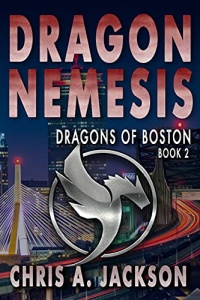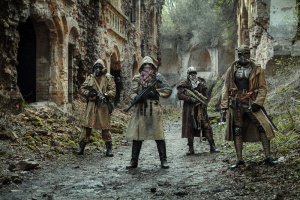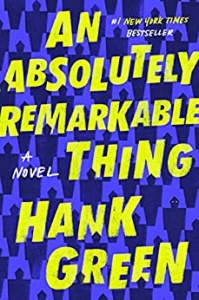
Amazon Cover
Dragons of Boston by Chris A. Jackson
- Dragon Dreams
- Dragon Nemesis
- Dragon Legacy
BOOK BLURB ON AMAZON for DRAGON DREAMS
Introducing a new techno-thriller from Chris A. Jackson – The Dragons of Boston!
The monster awakens…
Harvard PhD student Aleksi Rychenkna longs for the peace of solitary study, away from people, questions, and human interaction. With a new advisor, a new project, and a fascinating new mystery, a preserved specimen that defies identification and contains human DNA, she has everything she wants.
But the mystery runs deeper than Aleksi bargains for. Powerful people are interested in her work; people who can make or break a young scientist’s career. Then, after an accidental exposure to the specimen’s strange DNA, she finds herself…changing.
It begins with dreams, nightmares of blood filled with violent images and urges. When threatened by another student, her social anxiety shifts to aggression. Her reflexes and instincts sharpen, and she is becomes stronger and faster than she should be. Aleksi begins to realize her dreams are more than psychosis.
Because they’re not dreams at all. They’re memories. And now the powerful people aren’t just interested in her, they’re hunting her.
MY REVIEW for DRAGON DREAMS
Even keeping the best records, maintaining the best containment, doing everything right, things can go grievously wrong. When Aleski discovers the bone slab she is working on is from an entirely different dig, her world shifts on its axis. She had just changed advisors and started a new project. Now this … DNA and X-ray mess of paleontology. She does her best to continue with her project despite everything, including a nasty head cold and an on-campus murder.
If that isn’t enough, she dreams of dragons. And she isn’t the only one.
Character driven, this action-packed story keeps you moving to the very end.
Deeper thoughts
My biggest problem with the book is how much the main character’s (Aleski) personality changed after her infection. We got to know her as a person, identify with her, and she changed so much she became unrecognizable. But then, she did become a dragon.
The theme of the story does seem to be about transformation. Is the person what they look like on the outside or what they are on the inside personality wise? Are they their experiences, even when the experiences are forgotten? Are they something else entirely? The questions aren’t addressed head-on, but they do nibble in the back of your head as you read the book.

Amazon Cover
BOOK BLURB ON AMAZON for DRAGON NEMESIS
The stunning techno-thriller trilogy that began with Dragon Dreams continues!
Aleksi Rychenkna’s metamorphosis is complete.
A long-extinct evolutionary twist that lies hidden with the human genome now soars through the skies above Boston. Hunted by the government that would use her as a weapon, sought by a secretive organization that can reshape human flesh, and loved by the one man who keeps her horrible secret, Aleksi lives in the shadows.
But the transformation that reshaped Aleksi into Homo Draconis is contagious, and she harbors a plague that could reshape the world of mankind.
There is, however, the promise of hope. But can Aleksi trust those who say they can make her human again? If it means a chance to regain her life, to become Aleksi Rychenkna again, to be with the man she loves again, perhaps it’s worth the risk.
But the powers that want an army of dragons will risk humanity to get one. Aleksi is not the only Dragon of Boston, but those who made him know not what they have unleashed. This new dragon has but one irresistible urge burning in his mind: he must find Aleksi Rychenkna. For male dragons are driven only to eliminate rivals and procreate.
MY REVIEW for DRAGON NEMESIS
Even better than the first, Dragon Nemesis starts where Dragon Dream leaves off in the Dragons of Boston series.
Each book easily stands alone, but also supports the overarching narrative. No cliffhangers!
The new male dragon in town, David, is a world of difference from Penningly in so many ways. Will he be able to throw off the dragon instincts, as he has done all his life with his human instincts in response to his training and responsibilities? Or will his long history as a solider, as a killer (spy-assassin), make him succumb that much faster? Be that much more deadly in his skill and sanity? I fell in love a bit with David.
The cops show up again, as does Hutch’s ex and her family, and the DHS. The story is logical and full, the world and its characters fully realized. Great story!

Amazon Cover
BOOK BLURB ON AMAZON for DRAGON LEGACY
The Captive Dragon…
While Aleksi struggles to become human again, Lori Watkins, the single surviving victim of the rogue dragon, David Gilford, begins her metamorphosis in captivity.
Traumatized by the death of her fiancé and tormented by the dreams of the dragon she is becoming, Lori is struggling for sanity. She has only one hope, for others know she’s being held captive. But with a dragon in hand, Lori’s captors aren’t likely to make a deal with the secretive organization that wields more skill in manipulating the human genome than they do, and Aleksi’s new family will never trust the government with the ability to cure the Homo Draconis infection.
But angering the Department of Homeland Security is not unlike taunting a dragon, and Lori’s captors are as much out for vengeance as they are for the secret of creating an army of non-infectious dragons.
The two organizations are doomed to clash, and in the middle stands the man Aleksi loves. But if one thing is more dangerous than keeping a dragon captive, it’s threatening one’s loved ones.
MY REVIEW for DRAGON LEGACY
The conclusion of Dragon Legacy works as a stand-alone, though the story will be much better if you have read the whole story.
The first third of the book sags with personalities being pieced together; healing and hurting; and political maneuvers. Then the bombs go off and the rest of the book is a Thriller ride all the way.






